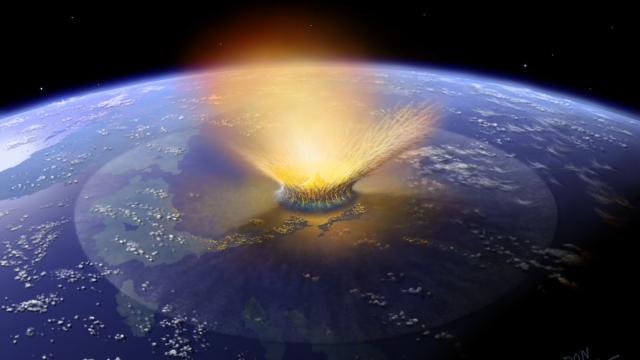New research examines the rock-dwelling microbes that eventually returned to the spot where a 10 km-wide asteroid smashed into Earth some 66 million years ago, killing off most life on the planet.
The Chicxulub impact event served as a kind of reset button, resulting in a distinct and isolated biosphere that’s still around today, according to new research published in Frontiers in Microbiology. What’s more, the asteroid created conditions that eventually proved beneficial to the microbial communities living deep beneath the impact site, in a finding that will be of interest to astrobiologists searching for signs of life on other planets. The new paper was co-led by Bettina Schaefer, a PhD student at Curtin University in Australia.
The asteroid struck Earth in what is now the Yucatan Peninsula, and it hit at the deadliest possible angle, releasing the equivalent of 10 billion Hiroshima-scale atomic bombs. The impact devastated surface environments, resulting in the extinction of all non-avian dinosaurs and three-quarters of all species on Earth. A crater measuring some 240 kilometres wide formed at the site, which has since become buried.
“The heat and pressure of the impact created a sterilised area that caused a localised extinction of the residing microbes,” Schaefer said in a release from Curtin University. “However, roughly one million years after the impact, the crater had cooled down to temperatures low enough for microbial life to return, and to evolve in isolation from life at the Earth’s surface over the last 65 million years.”
That said, not much is known about how this cataclysm affected life beneath the surface, specifically the area beneath the point of impact. As the authors write in their new study, the “deep microbial biosphere has an important role to play in global biogeochemical cycles, such as the carbon cycle,” so it’s of “considerable interest to investigate how it has been shaped by catastrophic geological events in the past.”
For the investigation, the team analysed core samples sourced by a drilling expedition led by the International Ocean Discovery Program and International Continental Scientific Drilling Program, which pulled samples at depths reaching 1,335 metres below the seafloor. These samples came directly from the peak ring of the Chicxulub crater, allowing the team to study its present-day deep microbial biosphere. To do so, the team performed gene sequences, cell counts, and incubation experiments.
“The data on the microbiology of the present-day Chicxulub impact crater have allowed us to make the first observations of how the impactor that caused the end-Cretaceous mass extinction led to a modern deep biosphere,” wrote the scientists in the study.
To be clear, the asteroid did not bring alien microbes to Earth (at least, not that we know), but it set the stage for a new community of microbes to move in, and they’ve basically been evolving in relative isolation ever since.
Indeed, the scientists found that the bacteria living in these rocks are significantly different from the bacteria found in the layer of rubble directly above, that is, the rubble that eventually filled in the crater. These microbes were found living in nutrient-poor conditions, and in rocks that are still quite warm, with temperatures reaching 70 degrees Celsius. A substantial number of microbes were found to be involved in sulphur oxidation, and with “diverse metabolic capabilities,” the authors wrote.
Remarkably, the asteroid, which struck so many millions of years ago, continues to shape life beneath the crater. The “abundance and diversity of the deep biosphere in the Chicxulub crater is still structured by the geological changes wrought in the first hours and days of the Cenozoic,” according to the paper.
Somewhat counterintuitively, the impact eventually resulted in improved habitability at the layer sandwiched between the hot lower regions and the post-impact sediment that collected above. The resulting increase in the channeling of fluids and the transport of nutrients and energy “caused a long-term improvement in the colonisation potential for deep subsurface microorganisms,” wrote the scientists.
Astrobiologists searching for signs of life on other planets should take notice of these findings. Planets like Mars may not be capable of hosting life at the surface, but the situation could be different below the crust. The same process, in which a large asteroid strikes a planetary body, could facilitate similar conditions to those seen below the Chicxulub crater, as these scientists speculate. Accordingly, impact craters on the Red Planet are “propitious places to focus scientific exploration missions to investigate habitable environments and to test the hypothesis of the presence of life on Mars,” the researchers conclude.
As Schaefer pointed out, deep rock-dwelling microbes eventually returned to Chicxulub after the impact — perhaps about 1 million years after, but the timeline remains uncertain. Research from last year showed that a gigantic magma chamber formed below the crater, and it lasted for potentially millions of years. We still have lots to learn about the Chicxulub impact and how it reshaped the planet and its various biospheres, but we’re learning new things at a rapid pace.
